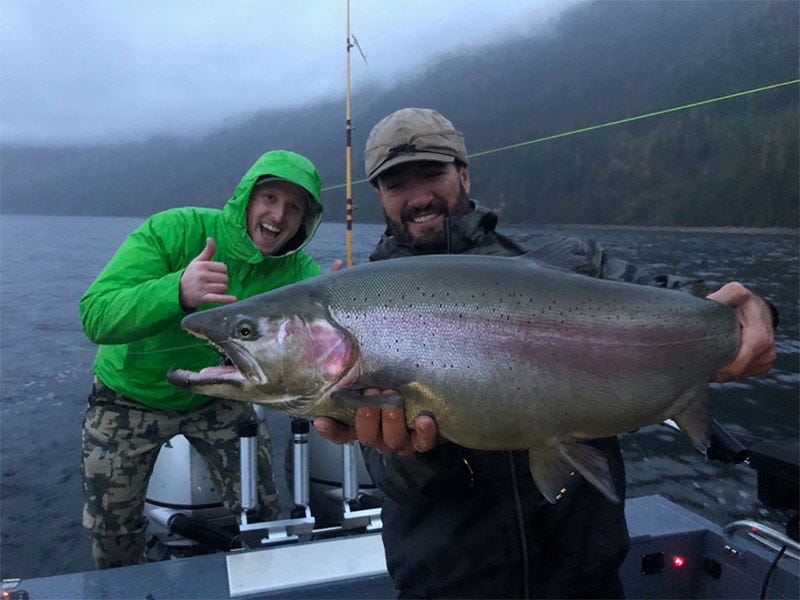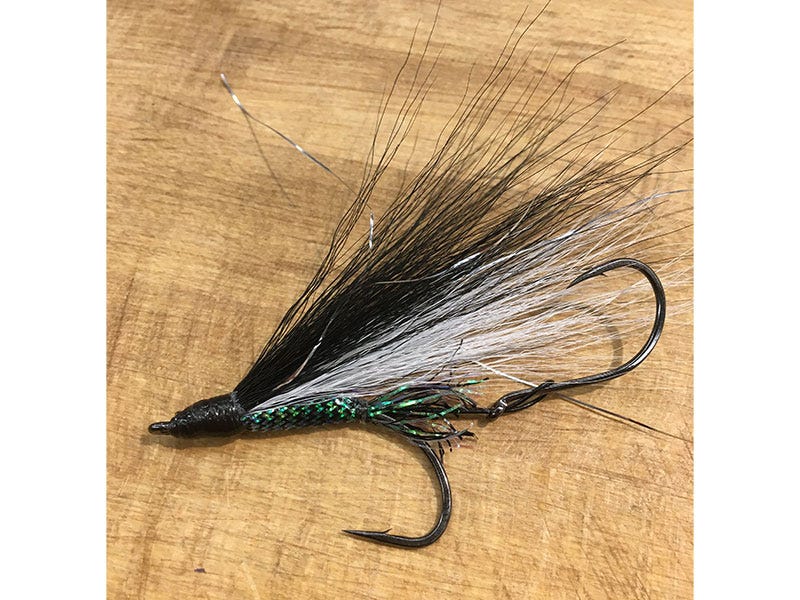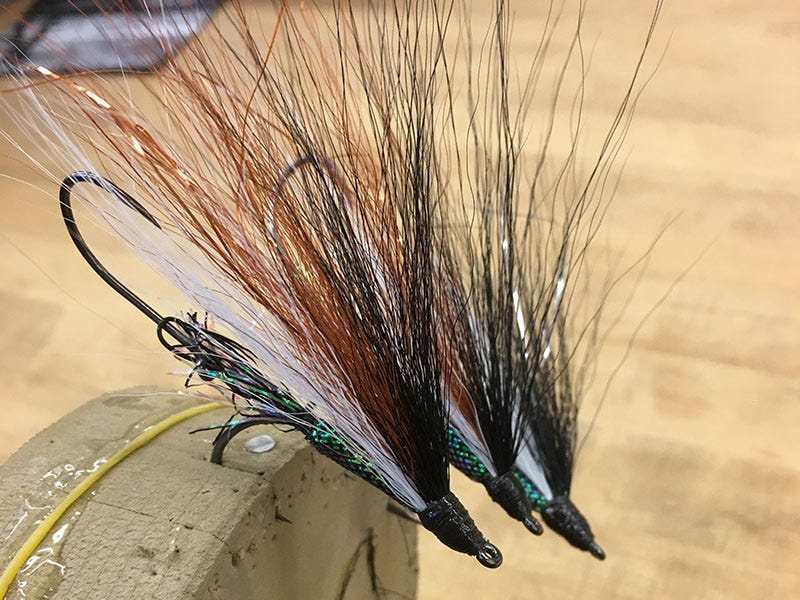Getting Set for Lake Trolling Flies Pt. 1

Many folks have the misconception that “flies” are only for the angler wading waist deep in the water waving a stick back and forth. Flies have been utilized in different manners over the years, they’re often used as components in many forms of tackle craft. For example, the infamous Rooster Tail in-line spinners use palmered hackles around a treble. Similarly, Mepps traditionally uses squirrel tail in the trailing treble. Though these are often very basic adaptations to conventional tackle, the techniques used to tie these materials to a hook still follows the same principles as many of the more intricate fly patterns used with a fly rod and reel. Out of all the “non-fly-fishing flies”, trolling flies are (in my opinion) some of the most fun to tie and create. Let your imagination lead you when finding your perfect color combinations. We often try to confine tackle craft and different techniques into one or a few small categories. However, that should not be the case; flies do have a place outside of the traditionalist idea of fly fishing. Getting started requires the same setups as any tyer. A solid vise, tool selection, and wide range of materials will have you spinning up your best fish-catching flies yet. The grand question is, what do you start with?
What are the best tactics for trolling steelhead? We explain.
Vises
Every fly needs a vise. Trust me, all vises are not created equal. Find yourself a vise that meets your tying needs or style. Two great (and affordable) vise options are the Renzetti Traveler 2000 and the Regal Medallion. The Renzetti 2000 series is a basic yet efficient rotary system vise that allows the fly to be rotated so it can be worked on from all angles. The Regal Medallion is a workhorse vise. The powerful jaws and spring-tension system hold even some of the largest hooks. I use both vises in my everyday tying, and I’ve been well pleased with their value, practicality, and simplicity.
Hooks
After the vise, comes the hooks. The style of trolling flies that seems to be the most popular in the Panhandle is a Frisky Jenny style fly; one with a leading hook where the material is tied in and a stinger hook. Two options for the front hook are a Gamakatsu B10S and a Gamakatsu SL11-3H. The size can be interchangeable based upon your preference. I’ve seen most anglers use size 2 - 2/0. The B10S is a super-strong and wider gap hook, allowing for solid hook sets. Its length also allows plenty of room for material. Similarly, the SL11-3H is a smaller gap, stainless steel, and a strong hook. The stainless steel has a slight give in it, which is perfect for tuning. As for stingers, you can use either a Gamakatsu Octopus or an Umpqua TMC784 salmon-steelhead interchangeably with either the B10S or SL11-3H. It’s all preference of the tyer and angler.
Threads
Having medium to heavy threads is a must on large trolling flies. The medium threads allow more wraps while still being able to apply pressure. This holds the hair in more securely than larger threads. Generally, UNI’s Big Fly 400D in black is also very popular. However, there are many more options that work well for cinching materials tighter without over-bulking the head. Veevus 240D Power Thread is heavy and lays flatter than most threads with its strength and size. Likewise, Veevus G.S.P (Gel Spun Polyethylene) is a super strong thread with hook bending power that will cinch materials tightly and not over-bulk the head.
Bobbins
Out of all the tools, I feel like I need to talk about bobbins for these larger flies. When using larger threads and big flies, we spin a lot of torque onto the hook and thread. The tubes of bobbins are susceptible to this torque, so choosing a good bobbin is key. Avoid any plastic tubes or tubes with plastic inserts. Look for bobbins with an integrated tube, meaning all one material. Stainless steel tubes or ceramic tubes are best. Dr. Slick makes a ceramic tube bobbin that works well with the forces we put on these threads. RiteBobbin’s “Half Hitch” bobbin has a stainless tube which can hold up extremely well to heavy threads. RiteBobbins also have a great tensioning system as well, so you can adjust how loose or how tight you want the thread spool to be on the bobbin. When it comes to tools, don’t sell yourself short!
Getting the right gear matters. Read our review of Simms' new gloves.
Connectors
Try your hardest to not overthink this step. I like to keep it simple by connecting my stinger to the main hook with a heavy mono such as 30# or 40# Maxima in Chameleon or Ultragreen. Maxima is hard mono that will not allow the stinger hook to sag while the fly is in the water. Some prefer wire, which is great for toothier trout. It increases your odds of retaining a larger fish on the line without wear, and it will generally last longer than most mono connections. Senyo’s Articulation Wire that is rated for hook size 6 and larger will hold up to the trophy on the end of your line. Downrigger wire is very popular as well and allows your fly to fall neutrally in the water column during stalls.
Body Material
Selecting a body size and color may be challenging, but mylar tubing is the most popular, most durable, and most practical body material for trolling flies. It comes in many different colors and can generally be found in three different sizes. Large is way too big for this application, so a medium or small will fit the bill. If you’re lazy like me, just wrapping tinsel around the shank to form a body works. I suggest coating it with head cement, UV resin, or another adhesive to keep its durability. If you don’t coat the tinsel, it often gets torn up by fish and will virtually become useless.

Flash
It’s all about that flash. This component is simple. Most flashabou has a very limp nature, which allows it to move freely with the rest of the fly. Flashabou comes in a very wide array of colors too. Kreelex flash from Montana Fly Company has brought a lot of new colors to the table, including a few with a holographic appearance. Kreelex flash also has a crinkled look to it, hence why it is one of my favorite flashes to tie with.
Hair
Bucktail and polar bear are no doubt the choice of most trolling anglers that tie their own flies. Bucktail is a pretty durable hair that now comes in quite a few different colors. Feel free to look at the bucktails and find the ones that have the best length for the size of flies you want to tie. Don’t get disappointed after you already started tying a fly. I suggest being picky about your materials, I know that I am. Again, bucktail is great and all, however, don’t overlook other materials. Polar bear is hard to come by, but if you have some, be sure to use it in your flies and don’t be afraid to mix it with other materials. Faux Bucktail is a synthetic bucktail made by the guys at Flymen Fishing Co. Spirit River. It has UV Yak Hair which has an awesome transparent effect in the water which can be tied in alone or accompanied by bucktail. One of my favorites is Steve Farrar’s Flash Blend by Just Add H2O Products. It’s a great wavy synthetic-bucktail-like material that has flash incorporated into it. Like everything else, there’s a multitude of color options. Some of these materials will give you an edge out on the water.
Head Glue & Eyes
Whatever you do, don’t use superglue to coat the fly. It is messy and will out-gas in your boxes, leading to a foggy and hard residue on everything. I’ve really gotten turned on to the UV resins. Loon UV resin is what we carry here at our North 40 Fly Shops. They make three consistencies of resins; thin, flow, and thick. Thin is best used to seal everything up because it penetrates the thread-head very well. I’ll cure that with a UV light and then add a dot of Loon Hard Head Orange on each side of the thread head to make an eye. After that dries, I then build a nice uniform head over the fly using the thick UV resin. This hard head is durable and will last.
Finally, another great option is Loon Hard Head in clear. This will allow you to put eyes on the fly, then have a clear coating around them. It does take longer to dry, and a fly spinner is the best way to get consistent heads with this product.


